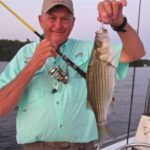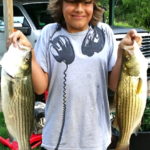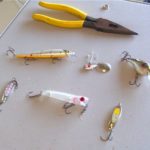
Lake Claiborne is stacked with stripers, and this lifelong angler knows exactly what it takes to put these hard fighters in the boat.
After an hour chasing sparse schools of striped bass across boat lanes, creek channels, coves and finally out into the big lake without a single strike, Donny Hood stopped for a second, calmly set his rod down and moved to the driver’s seat of his 22-foot Blazer Bay bay boat dubbed the Miss Judy.
He cranked up the big Yamaha outboard and headed off to a point on the south end of Lake Claiborne, where deep water met a shallow, underwater ridge.
“They’ll bunch up in a few minutes and come right up through here next, I bet, ” he said.
Soon, they did.
Those crazy stripers starting busting the water’s surface in bunches of five, 10 and what looked like 20 or 30.
It was like Mardi Gras: Hood and I were on the float, and the striped bass were crowding around like revelers and seemed to be saying “throw me something, Mister.”
We did.
The bait of choice was a 3/8-ounce white Worden Rooster Tail with a silver spinner. The fish went after it with a vengence.
Within 20 minutes, we each had our five-fish limit — and more. We caught and released fish for about 30 more minutes, and by the time the sun was setting I realized I needed more than a stout rod, good line and the right bait.
I needed a pain reliever for my aching shoulder because I had been in a tug of war with fish much stronger than they looked.
This is summer with “Captain D” on Lake Claiborne and his great little striper place (OK, there is no seafood in Lake Claiborne like the famous fast food restaurant of the same name).
But there are plenty of hungry fish — hybrid striped bass — in this 6,400-acre reservoir
“Captain D,” as Donny is called, can tell you how to put plenty of these feisty fish on your plate.
“I love fishing, and I really love fishing for stripers,” he said. “Of course, I like to take people out because that’s my business as a guide. But I don’t mind sharing information with anyone. Some fishermen are secretive, but I don’t mind helping people find the fish or learn how to catch them.
“Stripers are hardly ever in exactly the same place two days in a row, but if you go to the right areas and fish, pay attention and throw the right baits you can catch them. I like to help people catch fish, so I am always glad to help.”
How much does he love it? When I asked him if he fished every day, he politely smiled.
“No,” he said.
That’s because he usually fishes twice a day — especially when the fish are biting, which is most of the time for him.
Late summer and early fall are the best times to catch schooling stripers. Captain D’s knowledge of the lake, where he has spent 30 years fishing, shows.
He knows how to put you on fish.
Anglers might be surprised at the first piece of equipment Hood said is a must-have for Claiborne striper fishing: A pair of binoculars.
“There are so many places that they can be; you need to be able to see a long way to keep an eye out for action on the surface,” he said. “They can be coming up in the middle of the 1,000-foot channel, along a stump line up one of the creeks or down by the mouth of areas like Bear Creek
“The binoculars help you see a lot of water and find where the fish are the most active.”
Casting for stripers requires you move with the active fish and cast a long way, in many instances, and often in a good breeze because you are fishing in open water.
Captain D prefers to use a spinning reel.
“It seems like they always break water where you have to cast into the wind,” he explained. “Sometimes a baitcasting reel will backlash too easily when casting as far as you can into the wind.”
He doesn’t have statistics to back that up, but why question someone who spends as much time on the water as he does?
Hood’s favorite reel is a Mitchell Avocet IV, and he uses a variety of graphite spinning rods.
His favorite casting lure during the summer is the 3/8-ounce Rooster Tail, but he also uses a clear Storm Rattlin’ Chug Bug with red eyes with good success.
There’s a pretty easy process to deciding whether to cast or troll, Hood said.
“If you see them breaking the surface, follow them and cast out just past them,” he said. “Try and give the lure a quick jerk or two as soon as it hits the water, and they’ll turn on it and bust it.”
He said the jerking motion does a couple of things. First, it gets the spinner going and makes a good vibration; second, the quick flash makes the fish think it’s a baitfish, and they strike on reflex.
If you don’t see fish hitting on the surface, then that means trolling is the best approach.
“Sometimes the fish just don’t come up except right at sunrise and right before dark,” Hood said. “When that happens, troll where you have seen them school or along the edges of the channels. If you haven’t seen fish, cruise the lake and keep a close eye on your depth finder. When you see a school, go back and troll through it.”
For trolling, Hood prefers a deep-diving gold Smithwick Rouge, Little George or shad-colored deep-diving Little N. Trolling seems to be more effective when wind kicks up waves or there is a lot of boat traffic.
There’s also a third technique that works when you see big schools of stripers bunched up and suspended in 20 to 25 feet of water on your depth finder.
This is when Donny uses a big ½- to 3/8-ounce bucktail jig or silver spoon. Being prepared to employ all three will help you have a better chance at landing your limit.



